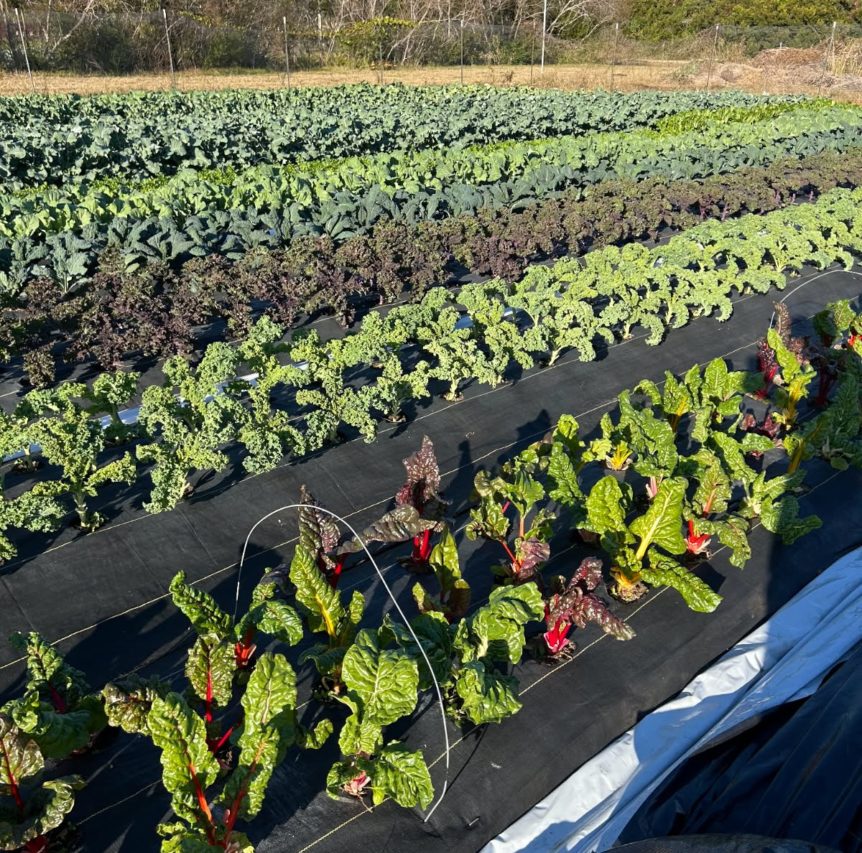
Clemson Extension agents provide updates in The South Carolina Grower this week about the status of various crops being produced throughout the state.
Coastal Region
Zack Snipes
- Despite a 29 degree Fahrenheit night and our first frost this fall, we had a beautiful week of weather post the cold weather. We could really use some rain.
- The cold weather and wind wilted some fall greens. Most damage occurred on the outside rows that took the brunt of the winds. The growing points look great, and with the weather we have coming, they should bounce back quickly.
- We have clean looking strawberries this year. I am a little concerned at the size of what we have in the field right now. We may need to use some row covers in the next few weeks to push them, but I would hold off for another 10 days or so.
- I am finding a good bit of Alternaria, aka brown bead, in broccoli right now. This is a fungal pathogen and can and should be managed when the broccoli is first pinning out or beginning its head formation. See this publication from UGA on management.
Midlands
Rob Last
- After a cold and windy start to the week, temperatures picked up to be very pleasant. Dry conditions persist, leading to an increase in soil moisture deficits.
- The freeze last week finished off the last of the warm-season crops. Timely destruction of the residues may help to reduce pest and disease carryover.
- Brassicas have been displaying some purpling early in the week, which is normal after a rapid cooldown. The purpling was growing out by the end of the week.
- Strawberries are developing well, pushing out new roots and leaves.
Daniel Lyon
- My name is Daniel Lyon. I am the new Commercial Horticulture Agent for Orangeburg, Calhoun, Sumter and Clarendon counties. I am from Irmo, South Carolina, and I have a Bachelor’s from Abraham Baldwin Agricultural College where I studied Ag Technology. Previously, I worked with UGA Extension where I mostly worked on row crop irrigation.
- Sudden cool temperatures and wind last week may have slowed some crops down, but the warm weather forecasted for this week should turn things around very quickly.
- Strawberries are looking very good despite some of the smaller crowns being planted and the cool weather. Phytophthora was discovered and identified by the discoloration of the roots.
- Purpling of leaves in brassicas last week was noticed as expected. With the warm weather predicted, phosphorus uptake will likely increase, reversing the discoloration. Black rot was noticed in a few areas as well. Lesions caused by the high winds will encourage the spread of the pathogen.
- Wilting caused by the high winds and cool temps was noticed in collards. Mature leaves may not recover, but new growth should be fine.
Upstate
Andy Rollins
- Last week, I recommended strawberry growers with cutoff plants from California that were planted around Oct. 21 cover their plants ahead of temperatures that ended up around 24 F. This is because many of these plants had only one leaf and needed more growth before being thrown into freezing temperatures like that. I still think that was the right call, even though it looks like we will be getting up to the high 70s this week. I would encourage growers in the Upstate to remove their covers Tuesday afternoon or Wednesday morning on these plants. I would have liked to have kept the covers on through this week, but when the predictions increased from highs of 70 to 71 F for two days to 75 to 77 F for three days, that’s what made me want to take them off. Covering and uncovering in the fall is a costly operation. If we could get cutoffs planted sooner, we wouldn’t have to manage the plants this way.
- I had one problem at a strawberry farm with major losses. Roots and crowns of 15% of the plugs were severely damaged. Immunostrip tests were negative for phytophthora root rot, but the grower applied Orondis Gold the day before I visited, approximately one month after planting. The sample was sent off for further testing, and we are waiting for a response. The grower had some issues with his irrigation system at the time of planting that may be associated with this problem. If you have problems in your strawberry plants, please submit them sooner rather than later. Scout for mites and army worms.
- We’re still working with new farms planned for planting next year and pruning decisions for some blueberry growers.










